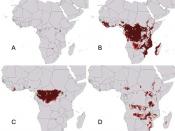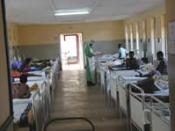Somewhere in the blistering jungle, in a mysterious green thicket that impedes the sun, lives a fatal disease rarely seen, but always present. A fatal disease that possibly lurked in the forest for perhaps thousands of years before rising 33 years ago in the Congo and earned the name of Ebola (WHO, 2008). Ebola received its name from the Ebola River in the Democratic Republic of the Congo (WHO, 2008). Factors in understanding Ebola include the agents of the disease, vulnerable populations, modes of transmission, control of the disease, cultural, social, and population beliefs of the disease. Many deadly viruses are known today, but none present a greater threat than Ebola.
Agent of EbolaThe Ebola virus is a member of the negative stranded RNA viruses known as the Filoviruses (CDC, 2002). The Filoviruses belong to the family of filoviridae, which can cause severe hemorrhagic fevers in both humans and primates.
Ebola is able to and typically will produce a sickness term the Ebola hemorrhagic fever. The precise source of the Ebola virus is still unidentified. Ebola is considered a severe biohazard because this disease does not have a vaccine to prevent it nor does Ebola have a cure. Because so little is known about Ebola the only preventative measures that can be taken is early detection or quarantine of people who are infected. People infected with the Ebola virus are known to have flu like symptoms that include high fevers, muscle aches, and joint pain. Ebola has four subtypes, which all were named for the regions of Africa where they came from and they are as follows: Ebola Reston, Ebola Sudan, Ebola Ivory Coast, Ebola Zaire, of these four only three is notorious to trigger disease in humans. Ebola Reston is the only known strands that is not lethal...


